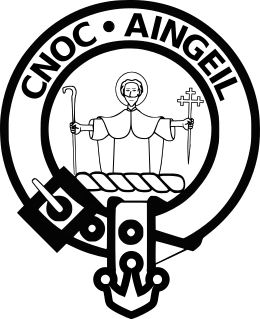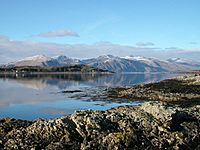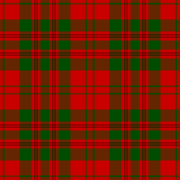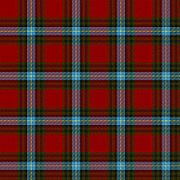Clan MacLea facts for kids
Quick facts for kids Clan MacLea or Livingstone |
|
|---|---|
| Mac Dhunnshleibhe and Mac an Léigh | |

Crest: A demi-man representing the figure of Saint Moluag Proper, his head ensigned of a circle of glory Or, having about his shoulders a cloak Vert, holding in his dexter hand the great Staff of Saint Moluag Proper and in his sinister hand a cross crosslet fitchée Azure.
|
|
| Motto | NI MI E MA'S URRAIN DHOMH |
| Slogan | CNOC AINGEIL |
| Profile | |
| District | Argyll |
| Plant badge | Grass of Parnassus |
| Chief | |
 |
|
| The Much Hon. Niall Livingstone of Bachuil | |
| Baron of the Bachuil | |
| Seat | Bachuil, Isle of Lismore |
The Clan MacLea is a historic Scottish clan from the Scottish Highlands. They traditionally lived in the Lorn area of Argyll, Scotland. Their main home is on the Isle of Lismore. Some members of Clan MacLea changed their name to Livingstone over time. Because of this, the Clan Livingstone Society also calls them the Highland Livingstones. The current leader, or chief, of Clan MacLea is known as the "Coarb of Saint Moluag". This means he is the special "Hereditary Keeper of the Great Staff of Saint Moluag."
Contents
Clan MacLea: Where the Names Come From
The Names MacLea and Livingstone
The names MacLea, MacLay, and similar spellings have a few possible origins. One idea is that MacLea comes from the Scottish Gaelic words Mac an Léigh. This means "son of the physician" or "son of the doctor." Other names like McKinley and MacNulty also come from this Gaelic name.
However, the most popular idea today is that MacLea comes from Mac Dhunnshleibhe. This means "son of Donn Sléibhe." Donn Sléibhe could mean "son of the brown-haired one" or "chieftain of the mountain." By the 1700s, MacLea became the common way to spell the name. Interestingly, the Mac Dhunnshleibhe family were also famous doctors in ancient Ireland.
The name Livingstone comes from a place called Livingston in West Lothian, Scotland. This town was named after a person called Leving, who lived in the early 1100s. Leving was the ancestor of the powerful Livingston family.
In the mid-1600s, James Livingston, a member of the Lowland Livingstons, spent time on the Isle of Lismore. It's believed that around this time, the MacLeas on Lismore started using the name Livingstone.
Connecting to Dunshleibe
Some historians believe that all the MacLeas and Highland Livingstones from Lismore might be related to a person named Dunshleibe. He was the son of Aedh Alain O'Neill, an Irish prince. This family line could go all the way back to Niall of the Nine Hostages, a very important High King of Ireland from the 400s. Dunshleibe is also thought to be the ancestor of other clans in western Argyll. These include the Lamonts, MacEwens, Maclachlans, MacNeils, and MacSweens.
Dunshleibe Ua Eochadha: A Royal Link
A more recent and accepted idea is that the MacLea clan comes from Ruaidhri Mac Duinnsleibhe. He was the last king of Ulidia, a kingdom in Ireland, and he died in the late 1100s. The Mac Duinnsleibhe name was used by the royal family of Ulidia. It was a proud way to show their royal background.
Historian Francis John Byrne wrote that only the royal family of Ulidia used the name Mac Duinnsleibhe. This shows their special status. Ruaidhri Mac Duinnsleibhe is listed as the 54th and last king of Ulidia.
According to Irish history, descendants of this family moved to Scotland after the English arrived in Ireland. There, they changed their name.
The Coarb of Saint Moluag

Saint Moluag was a Scottish missionary who lived in the 500s. He helped spread Christianity to the Picts in Scotland. Stories say that in 562, Saint Moluag won a race against Saint Columba to reach the large Isle of Lismore. Some historians believe Lismore was a special island for the Western Picts. It was even thought to be the burial place for their kings.
The "Coarb" is the special successor or keeper of a saint's items. The Great Staff of Saint Moluag, also called the Bachuil Mor, is believed to be the saint's original staff from the 500s. It is a simple wooden staff, about 38 inches long. It once had shiny copper plates covering it, and some pieces still remain.
In 1950, the Lord Lyon King of Arms officially recognized Livingstone of Bachuil as the Coarb of Saint Moluag. This means the Livingstone family has been the hereditary keepers of the staff for a very long time. An old document from 1544 mentions Iain McMolmore Vic Kevir. It says he was keeping the staff "as freely as the father, grandfather and great-grandfather and other predecessors of the said Iain."
Saint Moluag founded and led three schools and several monasteries. Because of this, the Lord Lyon sees him as a "sovereign lord." As his successor, the Coarb is seen as a special baron. He is allowed to have a unique red and white hat, called a Cap of Maintenance, in his coat of arms.
Clan History
Even though the clan has a very old history, it was not officially recognized by the Lord Lyon until 2003. The first official clan chief of Clan MacLea was William Jervis Alastair Livingstone of Bachuil, recognized in 2003. He represented the clan on the Standing Council of Scottish Chiefs. William Jervis Alastair Livingstone of Bachuil passed away in 2008. His son, The Much Hon. Niall Livingstone, became the new chief.
Civil War and Jacobite Risings
During the Scottish Civil War in the 1600s, the Livingstones stayed loyal to the King. Because of this, their lands suffered. First, they were affected by the Scottish Covenanters. Later, Oliver Cromwell's Parliamentarian forces also caused damage.
In the 1700s, Clan Livingstone supported the Jacobite rising of 1715. As a result, they lost some of their land and rights. The MacLeas (who were later called Livingstones) fought in the Appin Regiment at the Battle of Culloden in 1746. Donald Livingstone, who was only 18, bravely saved the Appin Standard during this battle.
Clan Battles
- Battle of Bealach na Broige: This battle was fought between various Highland clans from Ross and the Earl of Ross. The exact date is not clear. The "Clan-leajwe" (Clan Leay, or MacLeas) were part of the uprising. The Munroes and Dingwalls chased them and fought a fierce battle at Bealach na Broige. Many lives were lost on both sides. The MacLeas were almost completely wiped out.
- Achnacree (1557): The MacLeas of Achnacree suffered a great loss in 1557. They were supporting the MacDougalls of Lorn against the Clan Campbell of Inverawe. About 80 MacLea men were killed in this clan battle.
- Dunaverty (1647): Many members of Clan MacLea were killed during the Dunaverty Massacre. They had sided with the Clan MacDougall against the Campbells of Inverawe. Several MacLeas are listed among those who lost their lives at Dunaverty in 1647.
Clan Profile
Crest Badge, Clan Badge, and Clan Chief
- Crest badge: This badge combines the chief's crest and motto.
- Chief's crest: It shows a half-man figure of Saint Moluag. He has a golden halo and a green cloak. He holds the Great Staff of Saint Moluag in one hand and a blue cross in the other.
- Chief's motto (slogan): CNOC AINGEIL. This means "Hill of fire" in Scottish Gaelic. It comes from an ancient burial mound behind the chief's home.
- Chief's motto (alternate): NI MI E MA'S URRAIN DHOMH. This means "I shall do it if I can."
- Clan badge: The beautiful Flower of the Grass of Parnassus.
- Clan chief: Niall Livingstone of Bachuil. He is also known as the Baron of the Bachuil and the Coarb of St Moluag.
Tartans
| Tartan image | Notes |
|---|---|
 |
This is the modern Livingstone tartan. It is also called Livingstone Sett. Even though the Livingstones are connected to the Buchanans, MacDougalls, and Stewarts of Appin, this tartan looks different from theirs. It looks most like the MacDonell of Keppoch tartan. |
 |
This is the Livingston Dress tartan. It is also known as Livingston Dress. |
 |
This is the Livingstone or MacLay tartan. It is based on the MacLaine of Lochbuie tartan, which is very old, dating back before 1810. |
See also
- Maclay disambiguation

